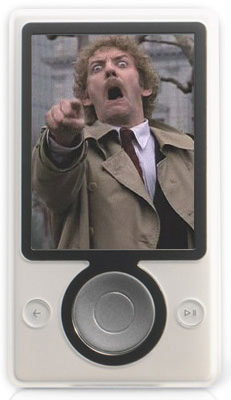| T. J. Watson Father and Son |
|---|
| Thomas J. Watson Sr. (1874 - 1956) | |
Thomas J. Watson Sr. in mid-1920's |
|
| Thomas J. Watson Jr. (1914 - 1993) | |
Thomas J. Watson Jr. in 1939 |
|
I am like a bird i have been sent here to sing i shall sing irrespective of whether there are listeners or not.
| T. J. Watson Father and Son |
|---|
| Thomas J. Watson Sr. (1874 - 1956) | |
Thomas J. Watson Sr. in mid-1920's |
|
| Thomas J. Watson Jr. (1914 - 1993) | |
Thomas J. Watson Jr. in 1939 |
|


It's 2015 and Microsoft has killed the iPod. The distinctive grey headphones of Zune players are pushed into the ears of commuters across the city. The iPod is a nostalgic memory, like Space Hoppers or Pet Rocks. Those who followed the MP3 player wars of the last decade remember Microsoft's daring assault on Apple.
It began in the summer of 2007, when Microsoft offered to let iTunes users download any songs they already owned for free from Microsoft's new online music store. The public needed a powerful incentive to switch to the newly released Zune, but for many users, even this was not enough. The iTunes system worked well, and the iPod was the only MP3 player with exclusive rights to the Clickwheel interface -- the only realistic way of scrolling though hundreds of songs. Microsoft needed a new line of attack.
In the summer of 2008, riled by the critical slating of Vista and determined to make a comeback, Microsoft launches its new campaign. Top executives in MS privately note that the company had survived both anti-trust legislation and copyright battles in the past. So Microsoft decides to use the biggest gun in its armoury. It will use the same tactic it allegedly used to defeat rival OS DR-DOS in 1991.
A Windows Vista update becomes available at the end of 2008. Microsoft claim this is an 'essential security fix' for all Windows machines. Over the next few months, Windows users notice that their iPods are behaving erratically. Song transfers are unreliable and iTunes often loses tracks, sometimes corrupting an entire library of songs.
In early 2009, Apple sues Microsoft, claiming that the company is inserting code into its OS that purposely corrupts iTunes. Microsoft refutes the claims, but refuses to reveal the code behind Vista, arguing that to do so would violate DMCA law. The judge sides with Microsoft and Apple's market share nosedives.
And so here we are, in 2015, sat on a train, grey headphones in our ears, Vista on our computers. We make phone calls with Microsoft phones, our cars are powered by Microsoft propulsion units, our voting mechanisms are administered by Redmond.
A man opposite you reaches into his pocket and draws out a small white box with white headphones attached. It looks oddly familiar -- a distant memory flickers. Slowly, the whole carriage turns and points at the man. Then the shrieking begins. A BusinessWeek journalist reveals the management principles that propelled Indian phenomenon Wipro from a tiny start-up to a $2 billion market leader
A BusinessWeek journalist reveals the management principles that propelled Indian phenomenon Wipro from a tiny start-up to a $2 billion market leader


| General | Network | HSDPA / GSM 850 / 900 / 1800 / 1900 |
|---|---|---|
| Announced | 2006, September | |
| Status | Coming Soon |
| Size | Dimensions | 99 x 53 x 21 mm, 90 cc |
|---|---|---|
| Weight | 120 g |
| Display | Type | TFT, 16M colors |
|---|---|---|
| Size | 240 x 320 pixels, 2.6 inches |
| Ringtones | Type | Polyphonic (64 channels), Monophonic, True Tones, MP3 |
|---|---|---|
| Customization | Download | |
| Vibration | Yes |
| Memory | Phonebook | Yes |
|---|---|---|
| Call records | Yes | |
| Card slot | microSD (up to 2GB), hot swap, 128 MB card included | |
| - 160 MB internal memory |
| Data | GPRS | Class 10 (4+1/3+2 slots), 32 - 48 kbps |
|---|---|---|
| HSCSD | No | |
| EDGE | Class 32, 296 kbps; DTM Class 11, 236.8 kbps | |
| 3G | HSDPA | |
| WLAN | Wi-Fi 802.11 b/g, UPnP technology | |
| Bluetooth | Yes, v2.0, A2DP | |
| Infrared port | Yes | |
| USB | Yes, v2.0, Pop-Port |
| Features | OS | Symbian OS 9.2, S60 rel. 3.0 |
|---|---|---|
| Messaging | SMS, MMS, Email, Instant Messaging | |
| Browser | WAP 2.0/xHTML, HTML | |
| Games | Downloadable | |
| Colors | Silver | |
| Camera | 5 MP, 2592 x 1944 pixels, Carl Zeiss optics, autofocus, video(VGA 30fps), flash; secondary CIF videocall camera | |
| - Built-in GPS navigation - Installed Maps application covering over 100 countries - Dual slide design - Java MIDP 2.0 - MP3/AAC/AAC+/eAAC+/WMA player - 3.5 mm audio output jack - Stereo FM Radio - Organiser - Office document viewer - T9 - Push to talk - Voice dial/memo - Built-in handsfree |
| Battery | Standard battery, Li-Ion 950 mAh (BL-5F) | |
|---|---|---|
| Stand-by | Up to 220 h | |
| Talk time | Up to 6 h 30 min |

 SUN 'N' SANDS
SUN 'N' SANDS


The inspiration behind this joint collaboration between Samsung, Intel® and Microsoft lies in the limitations with traditional mobile devices.
Restrictions placed on Smart phones, PDA's, PMP's and MP3 players, such as slow bandwidth, poor viewing, sound quality and trouble syncing with PC’s coupled with the demand for even greater mobility alternatives to notebook’s has created a desire in the market for convergence.
Slim, sleek and shining through with features, the Samsung Q1 is designed to match the all these demands for high performance mobile computing and the desire for digital convergence. Featuring fully functional PC power, instant multimedia, car navigation and the latest wireless internet technologies, all displayed on a stunning 7” touch screen. And at just 779g you can take everywhere and do everything. With the Samsung Q1 it’s not that hard to imagine.
Samsung challenges the limits of mobile technology with the launch of Q1, a new concept in digital multimedia convergence. Samsung’s new concept Q1 places emphasis on perfectly balancing connectivity, entertainment and computing performance with ultra mobility. The Q1 offers you the freedom and flexibility to go anywhere and do everything.
Thanks to the Samsung Q1, all digital devices now converged and you can do away with all your traditional accessories: